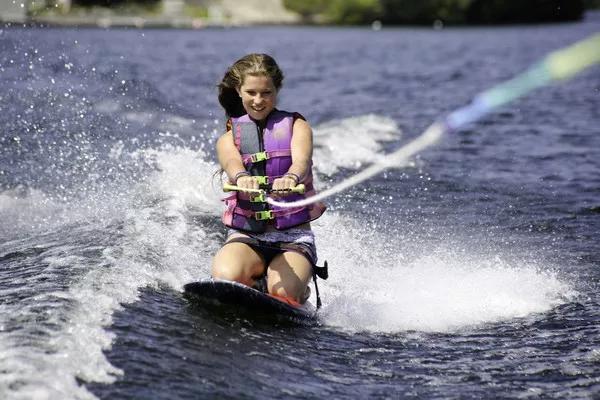Kneeboarding is an exhilarating water sport that combines elements of surfing, waterskiing, and wakeboarding. Unlike these other water sports, kneeboarding offers a unique experience, allowing participants to kneel on a buoyant board while being towed behind a boat. Whether you’re a complete novice or have some experience with water sports, mastering kneeboarding can be an incredibly rewarding endeavor. In this comprehensive guide, we’ll walk you through everything you need to know to get started with kneeboarding, from selecting the right equipment to mastering essential techniques.
Getting Started: Essential Equipment
Before hitting the water, it’s crucial to ensure you have the right equipment. Here’s what you’ll need:
1. Kneeboard: The most important piece of equipment is, of course, the kneeboard itself. Kneeboards come in various shapes and sizes, but for beginners, it’s best to start with a wider, more stable board that offers plenty of buoyancy. Look for a kneeboard with padded knee wells for comfort and a hook for attaching the tow rope.
2. Tow Rope: Choose a tow rope specifically designed for kneeboarding. These ropes are typically shorter than those used for waterskiing or wakeboarding, usually around 50-75 feet in length. A shorter rope helps keep you closer to the boat’s wake, making it easier to control your movements.
3. Life Jacket: Safety should always be a top priority when participating in water sports. Make sure you wear a properly fitting Coast Guard-approved life jacket at all times while kneeboarding.
4. Wetsuit (Optional): Depending on the water temperature and personal preference, you may want to invest in a wetsuit to keep you warm and protect your skin from abrasions.
5. Helmet (Optional): While not always necessary, wearing a helmet can provide an extra layer of protection, especially for beginners who may take a few spills while learning.
Mastering the Basics: Technique Tips for Beginners
Now that you have your equipment sorted, it’s time to hit the water and start kneeboarding! Follow these steps to master the basics:
1. Board Position: Start by kneeling on the kneeboard with your knees positioned in the padded wells. Keep your feet together and your weight centered on the board for stability.
2. Grip the Handle: Hold onto the tow rope handle with both hands, keeping your arms straight and your elbows slightly bent. The handle should be positioned at waist level.
3. Body Position: As the boat begins to pull you, lean back slightly and keep your chest up. Avoid leaning too far forward, as this can cause you to lose balance.
4. Stay Relaxed: It’s natural to feel tense, especially if you’re new to kneeboarding, but try to relax your muscles as much as possible. Tension can hinder your ability to control the board and make it harder to maintain your balance.
5. Control Your Speed: Communicate with the boat driver to adjust your speed as needed. Slower speeds are ideal for beginners, allowing you to focus on your technique without feeling overwhelmed.
6. Practice Turns: Once you’re comfortable cruising behind the boat, practice making gentle turns by shifting your weight slightly in the direction you want to go. Start with small, gradual movements until you feel confident enough to attempt sharper turns.
7. Learn to Get Up: One of the trickiest parts of kneeboarding for beginners is learning how to get up out of the water. To do this, start in a kneeling position with the tow rope handle in your hands. As the boat begins to pull you, gradually shift your weight forward and stand up on the board, keeping your knees bent and your weight centered.
8. Mastering the Deep Water Start: Once you’ve mastered getting up on the board from a kneeling position, you can progress to the deep water start. To do this, float on your back with the kneeboard in front of you and the tow rope handle in your hands. Signal to the boat driver that you’re ready, and as the boat begins to pull you, bring your knees up to your chest and slip your feet into the knee wells, then stand up on the board as you would from a kneeling position.
Safety Tips for Kneeboarding
While kneeboarding is a fun and exhilarating sport, it’s essential to prioritize safety at all times. Here are some important safety tips to keep in mind:
1. Wear a Life Jacket: Always wear a properly fitting Coast Guard-approved life jacket while kneeboarding.
2. Communicate with the Boat Driver: Establish clear communication with the boat driver before getting in the water. Make sure they know your skill level and preferences regarding speed and direction.
3. Start Slow: If you’re new to kneeboarding, start at slower speeds until you feel comfortable and confident in your abilities.
4. Practice Falling Safely: It’s inevitable that you’ll take a few spills while learning to kneeboard. Practice falling safely by keeping your arms in and away from the tow rope to avoid injury.
5. Be Aware of Your Surroundings: Always be aware of your surroundings and any potential hazards in the water, such as other boats, swimmers, or obstacles.
6. Stay Hydrated: Spending time in the sun and water can be dehydrating, so be sure to drink plenty of water throughout your kneeboarding session to stay hydrated.
Conclusion
Kneeboarding is a thrilling water sport that offers endless opportunities for fun and excitement. By following the tips and techniques outlined in this guide, beginners can quickly master the basics and progress to more advanced maneuvers. Remember to prioritize safety at all times, wear appropriate protective gear, and communicate effectively with the boat driver. With practice and patience, you’ll be carving up the waves like a pro in no time!

